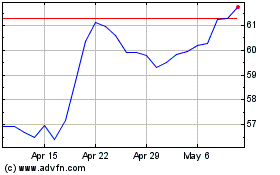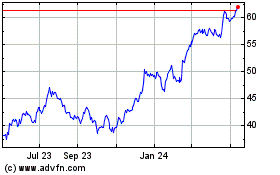Wells Fargo Is the Loser in the New Era for Banking
January 13 2017 - 2:23PM
Dow Jones News
By Aaron Back
The outlook for the top U.S. banks is brightening, but Wells
Fargo is being left behind.
That showed clearly when the three major banks reported earnings
Friday. Fourth-quarter net profit rose by 24% from a year earlier
at J.P. Morgan Chase, and by 43% at Bank of America , both beating
already high expectations.
Wells Fargo, on the other hand, saw net profits decline by 5.4%
from a year earlier, coming in below analyst expectations. Most
significantly, Wells Fargo is on the cusp of losing its title as
the highest returning big bank to J.P. Morgan, making its valuation
look increasingly unrealistic.
The fallout from the bank's account-sales fiasco continues to
hurt, mainly through elevated costs. There was also a big, $592
million loss associated with interest-rate hedges, which
essentially offset hedging gains earlier in 2016.
The bigger picture is that Wells Fargo isn't set up to benefit
as much from the current environment. Its balance sheet is
deliberately geared toward a low interest rate environment by
holding more long-dated assets. As recently as May the bank said it
continues to plan for a lower-for-longer rates environment.
Wells Fargo's guidance on how it will be affected by rates is
also less detailed than peers. On a conference call with analysts,
Chief Financial Officer John Shrewsberry suggested the Federal
Reserve's December interest-rate increase, along with recent market
moves in long-term rates, would contribute extra interest income
somewhere north of $150 million a quarter. That would be an
incremental gain of about 1.2% from the level of net interest
income in the fourth quarter of 2016.
Bank of America, by contrast, was clearer and more optimistic,
saying it expects an extra $600 million in the first quarter, or an
incremental gain of 5.8%.
Wells Fargo, a more retail-oriented bank than its peers, is also
suffering from its relatively small trading operation. This wasn't
an issue during the years that bond and currency trading activity
was weak. But volumes suddenly rebounded in the second half of last
year, handing a big windfall to banks like J.P. Morgan.
The clearest indication that Wells Fargo's edge is slipping is
its return on equity, the ultimate gauge of value creation for
shareholders. This fell to 10.9% in the fourth quarter, from 11.9%
a year earlier. That compares with 11% for J.P. Morgan in the
fourth quarter, the first time in years that Wells Fargo wasn't the
top returning big bank.
Despite that, Wells Fargo shares are trading at 1.57 times book
value, compared with 1.36 for J.P. Morgan and 0.96 for Bank of
America. This premium looks less justified with every passing
quarter.
Write to Aaron Back at aaron.back@wsj.com
(END) Dow Jones Newswires
January 13, 2017 14:08 ET (19:08 GMT)
Copyright (c) 2017 Dow Jones & Company, Inc.
Wells Fargo (NYSE:WFC)
Historical Stock Chart
From Mar 2024 to Apr 2024

Wells Fargo (NYSE:WFC)
Historical Stock Chart
From Apr 2023 to Apr 2024
